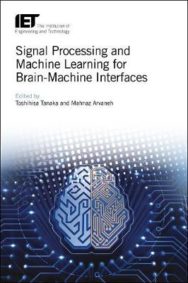
ABOUT THIS BOOK
PUBLISHER: Institution of Engineering and Technology
FORMAT: Hardback
ISBN: 9781785613982
RRP: £125.00
PAGES: 400
PUBLICATION DATE:
September 1, 2018
BUY THIS BOOK
As an Amazon Associate and Bookshop.org affiliate we earn from qualifying purchases.
Signal Processing and Machine Learning for Brain-Machine Interfaces
Toshihisa Tanaka
Mahnaz Arvaneh
Brain machine interfacing or brain computer interfacing (BMI/BCI) is an emerging and challenging technology used in engineering and neuroscience. The ultimate goal is to provide a pathway from the brain to the external world via mapping, assisting, augmenting or repairing human cognitive or sensory-motor functions.In this book an international panel of experts introduce signal processing and machine learning techniques for BMI/BCI and outline their practical and future applications in neuroscience, medicine, and rehabilitation, with a focus on EEG-based BMI/BCI methods and technologies. Topics covered include discriminative learning of connectivity pattern of EEG; feature extraction from EEG recordings; EEG signal processing; transfer learning algorithms in BCI; convolutional neural networks for event-related potential detection; spatial filtering techniques for improving individual template-based SSVEP detection; feature extraction and classification algorithms for image RSVP based BCI; decoding music perception and imagination using deep learning techniques; neurofeedback Games using EEG-based Brain-Computer Interface Technology; Affective Computing System, and more.This book is ideal for researchers, engineers, professionals and specialists in signal processing, computer science, biomedical engineering, computational engineering and machine learning, imaging, neural networks and control engineering who need to gain fundamental and cutting edge knowledge in the fields of BMI/BCI, as well as advanced students and young researchers who are planning to study and/or enter this field. It is also for neuroscientists who do not have signal processing and machine learning background and need to know about BMI/BCI concepts and technologies.









